The Cambridge History of China. Vol. 06. Alien Regimes and Border States, 907-1368
Подождите немного. Документ загружается.

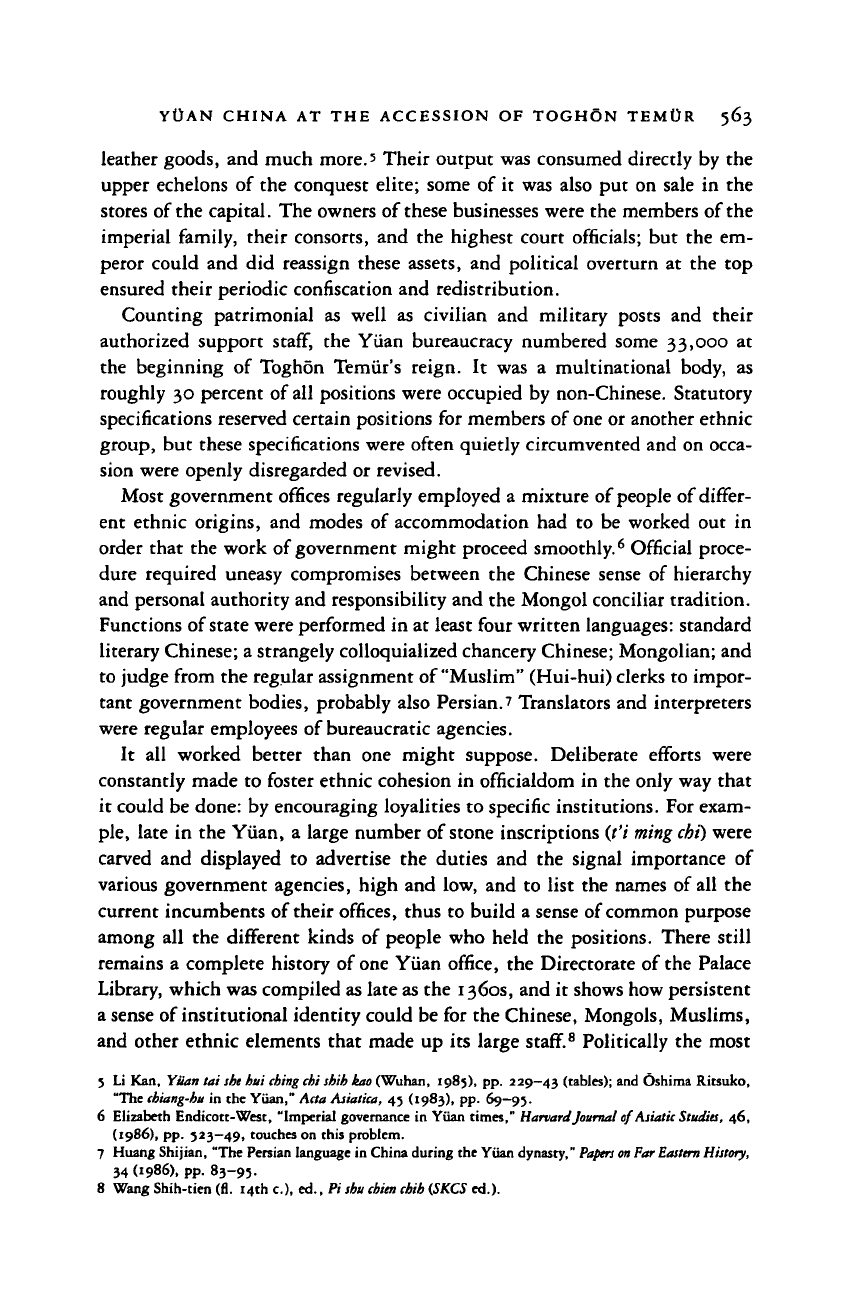
YOAN CHINA
AT THE
ACCESSION
OF
TOGHON TEMOR
563
leather goods,
and
much more.' Their output
was
consumed directly
by the
upper echelons
of the
conquest elite; some
of it was
also
put on
sale
in the
stores
of the
capital.
The
owners
of
these businesses were
the
members
of the
imperial family, their consorts,
and the
highest court officials;
but the em-
peror could
and did
reassign these assets,
and
political overturn
at the top
ensured their periodic confiscation
and
redistribution.
Counting patrimonial
as
well
as
civilian
and
military posts
and
their
authorized support
staff, the
Yuan bureaucracy numbered some 33,000
at
the beginning
of
Toghon Temiir's reign.
It was a
multinational body,
as
roughly
30
percent
of
all positions were occupied
by
non-Chinese. Statutory
specifications reserved certain positions
for
members
of
one
or
another ethnic
group,
but
these specifications were often quietly circumvented
and on
occa-
sion were openly disregarded
or
revised.
Most government offices regularly employed
a
mixture
of
people
of
differ-
ent ethnic origins,
and
modes
of
accommodation
had to be
worked
out in
order that
the
work
of
government might proceed smoothly.
6
Official proce-
dure required uneasy compromises between
the
Chinese sense
of
hierarchy
and personal authority
and
responsibility
and the
Mongol conciliar tradition.
Functions
of
state were performed
in at
least four written languages: standard
literary Chinese;
a
strangely colloquialized chancery Chinese; Mongolian;
and
to judge from
the
regular assignment
of
"Muslim" (Hui-hui) clerks
to
impor-
tant government bodies, probably also Persian.
1
Translators
and
interpreters
were regular employees
of
bureaucratic agencies.
It
all
worked better than
one
might suppose. Deliberate efforts were
constantly made
to
foster ethnic cohesion
in
officialdom
in the
only
way
that
it could
be
done:
by
encouraging loyalities
to
specific institutions.
For
exam-
ple,
late
in the
Yuan,
a
large number
of
stone inscriptions
(t'i
ming
chi)
were
carved
and
displayed
to
advertise
the
duties
and the
signal importance
of
various government agencies, high
and low, and to
list
the
names
of all the
current incumbents
of
their offices, thus
to
build
a
sense
of
common purpose
among
all the
different kinds
of
people
who
held
the
positions. There still
remains
a
complete history
of
one Yuan office,
the
Directorate
of the
Palace
Library, which
was
compiled
as
late
as the
1360s,
and it
shows
how
persistent
a sense
of
institutional identity could
be for the
Chinese, Mongols, Muslims,
and other ethnic elements that made
up its
large
staff.
8
Politically
the
most
5
Li Kan,
Yuan
tai
she
hui
thing chi shih kao (Wuhan, 198;),
pp.
229—43 (tables);
and
Oshima Ritsuko,
"The
chiang-hu
in the
Yuan," Acta Asiatica,
45
(1983),
pp.
69—95.
6 Elizabeth Endicott-West, "Imperial governance
in
Yuan times," Harvard Journal of Asiatic
Studies,
46,
(1986),
pp.
523-49, touches
on
this problem.
7 Huang Shijian,
"The
Persian language
in
China during
the
Yuan dynasty,"
Papers on
Far
Eastern
History,
34 (1986),
pp.
83-95.
8 Wang Shih-tien
(fl. 14th c), ed., Pi
sbu
cbien
cbib (SKCS
ed.).
Cambridge Histories Online © Cambridge University Press, 2008

564 SHUN-TI AND THE END OF YOAN RULE IN CHINA
important manifestation of interethnic institutional cohesion in Toghon
Temiir's reign was to be found in the Censorate, whose members insisted on
their right of remonstrance and who therefore played a pivotal role in high-
level political processes right to the end of the Yuan dynasty.
Foreign participation in government helped bloat its size. To take one
example, the high court of justice, whose jurisdiction was limited to cases
involving Mongols or aliens in the two capitals, employed a staff of ninety-
six, headed by forty-two Mongolian judges
(jarghuchi),
each of whom held
the very high civil service rank of iB and enjoyed the accompanying high
salary and perquisites.
9
The problem of overstaffing
{Jung kuan)
was voiced
occasionally at court in Toghon Temiir's time, but for political reasons the
Yuan ascendancy was never able to go too far for too long in cutting supernu-
merary positions, despite the shortages of revenue.
There were several recruitment paths for the bureaucracy in the late Yuan.
Most lower officials served an apprenticeship as clerks or Confucian school-
teachers. Young members of the conquest elite (and some Chinese) were first
groomed and informally scrutinized as
kesigden,
hereditary guards or house-
men to the monarch and his family. The descendants of three warriors who
had been Chinggis Khan's closest comrades headed this corps, which came to
number some thirteen thousand young men, and it has been characterized as
a "cradle of officialdom" and the "citadel of the Yuan ruling class."
10
The
kesigden
enjoyed what was known in Chinese as
ken
chiao,
literally, "roots and
feet," an invidious reference to their having an aristocratic leg up on everyone
else.
The triennial Confucian examination system, instituted in 1315, was
statistically a minor port of entry into the lower bureaucracy (there was a
total of only some 550
cbinshih
degree holders by 1333, at most 2 percent of
the officials), but as a matter of politics it was crucial. The system was
heavily weighted in favor of Mongols (a small pool of candidates and an easy
examination) and against southern Chinese (a huge pool of candidates and a
demanding examination), yet despite these statutory inequalities, the system
did create a common outlook and interethnic cohesion among the degree
holders.
The examination round of 13 3
3,
which had begun in the spring, ended with
the
final
palace examination in the ninth lunar month of that year, shortly after
the young emperor's return to Ta-tu from Shang-tu." This was the first
examination under the Yuan to produce its full quota for all ethnic groups,
9 Sung Lien et al., eds., Yiian shib (Peking, 1976), 87, pp. 2187-8 (hereafter cited as YS).
10 Hsiao Ch'i-ch'ing, The military
establishment
of the Yiian dynasty (Cambridge, Mass., 1978), pp. 39—44;
see also his Yiian tai sbih hi in t'an (Taipei, 1983), pp. 141-230.
11 Sung Chiung (1294-1346),
Yen-sbib
chi (SKCS ed.), 15, p. 13a.
Cambridge Histories Online © Cambridge University Press, 2008
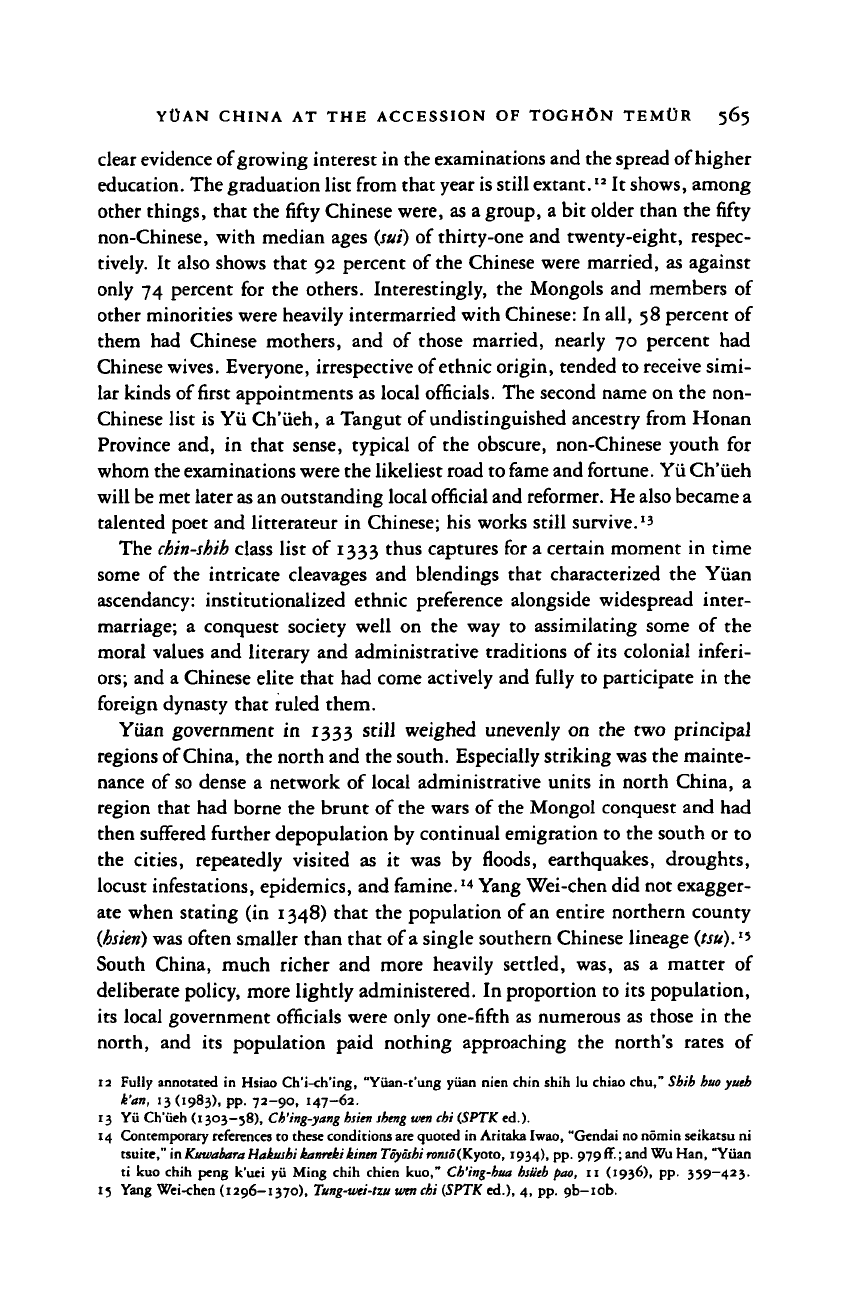
YOAN CHINA AT THE ACCESSION OF TOGHON TEMCR 565
clear evidence of growing interest in the examinations and the spread of higher
education. The graduation list from that year is still extant." It shows, among
other things, that the fifty Chinese were, as a group, a bit older than the fifty
non-Chinese, with median ages
(sui)
of thirty-one and twenty-eight, respec-
tively. It also shows that 92 percent of the Chinese were married, as against
only 74 percent for the others. Interestingly, the Mongols and members of
other minorities were heavily intermarried with Chinese: In all, 58 percent of
them had Chinese mothers, and of those married, nearly 70 percent had
Chinese
wives.
Everyone, irrespective of ethnic origin, tended to receive simi-
lar kinds of first appointments as local officials. The second name on the non-
Chinese list is Yii Ch'iieh, a Tangut of undistinguished ancestry from Honan
Province and, in that sense, typical of the obscure, non-Chinese youth for
whom the examinations were the likeliest road to fame and fortune. Yii Ch'iieh
will be met later
as
an outstanding local official and reformer. He
also
became
a
talented poet and litterateur in Chinese; his works still survive.'
3
The
chin-shih
class list of 1333 thus captures for a certain moment in time
some of the intricate cleavages and blendings that characterized the Yuan
ascendancy: institutionalized ethnic preference alongside widespread inter-
marriage; a conquest society well on the way to assimilating some of the
moral values and literary and administrative traditions of its colonial inferi-
ors;
and a Chinese elite that had come actively and fully to participate in the
foreign dynasty that ruled them.
Yuan government in 1333 still weighed unevenly on the two principal
regions of China, the north and the south. Especially striking was the mainte-
nance of so dense a network of local administrative units in north China, a
region that had borne the brunt of the wars of the Mongol conquest and had
then suffered further depopulation by continual emigration to the south or to
the cities, repeatedly visited as it was by floods, earthquakes, droughts,
locust infestations, epidemics, and famine.
14
Yang Wei-chen did not exagger-
ate when stating (in 1348) that the population of an entire northern county
{hsien)
was often smaller than that of a single southern Chinese lineage
(tsu).
1
*
South China, much richer and more heavily settled, was, as a matter of
deliberate policy, more lightly administered. In proportion to its population,
its local government officials were only one-fifth as numerous as those in the
north, and its population paid nothing approaching the north's rates of
12
Fully annotated
in
Hsiao
Ch'i-ch'ing,
"Yiian-t'ung yuan nien chin shih
lu
chiao
chu,"
Shih huo yueb
k'an, 13
(1983),
pp.
72-90,
147-62.
13 Yii Ch'fieh (1303-58), Ch'ing-yang
hsien
ihtng wen chi (SPTK ed.).
14 Contemporary references to these conditions are quoted in Aritaka Iwao, "Gendai no nomin seikatsu ni
tsuite,"inKuwabaraHakushikanrtkikinenToySshironso(Kyoto, 1934), pp. 979ff.;and WuHan, "Yuan
ti Icuo chih peng
k'uei
yii Ming chih chien kuo," Ch'ing-hua
hsueh
pan, 11 (1936), pp. 359—423.
15 Yang Wei-chen (1296—1370), Tung-wei-tzu wen chi (SPTK ed.), 4, pp. 9b—10b.
Cambridge Histories Online © Cambridge University Press, 2008
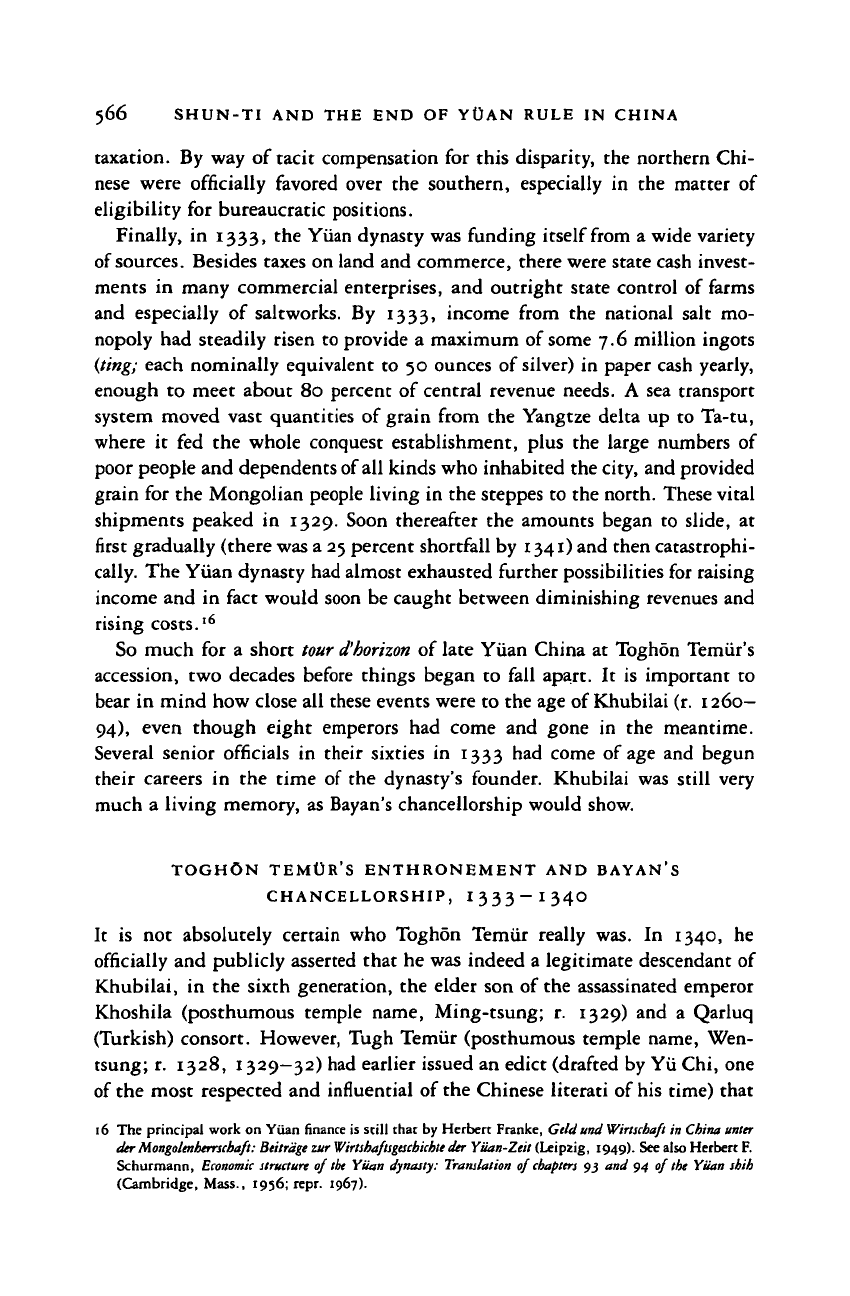
566 SHUN-TI AND THE END OF YOAN RULE IN CHINA
taxation. By way of tacit compensation for this disparity, the northern Chi-
nese were officially favored over the southern, especially in the matter of
eligibility for bureaucratic positions.
Finally, in 1333, the Yuan dynasty was funding itself from a wide variety
of
sources.
Besides taxes on land and commerce, there were state cash invest-
ments in many commercial enterprises, and outright state control of farms
and especially of saltworks. By 1333, income from the national salt mo-
nopoly had steadily risen to provide a maximum of some 7.6 million ingots
(ting;
each nominally equivalent to 50 ounces of silver) in paper cash yearly,
enough to meet about 80 percent of central revenue needs. A sea transport
system moved vast quantities of grain from the Yangtze delta up to Ta-tu,
where it fed the whole conquest establishment, plus the large numbers of
poor people and dependents of all kinds who inhabited the city, and provided
grain for the Mongolian people living in the steppes to the north. These vital
shipments peaked in 1329. Soon thereafter the amounts began to slide, at
first gradually (there was a
25
percent shortfall by 1341) and then catastrophi-
cally. The Yuan dynasty had almost exhausted further possibilities for raising
income and in fact would soon be caught between diminishing revenues and
rising costs.'
6
So much for a short
tour
d'horizon
of late Yuan China at Toghon Temiir's
accession, two decades before things began to fall apart. It is important to
bear in mind how close all these events were to the age of Khubilai (r. 1260-
94),
even though eight emperors had come and gone in the meantime.
Several senior officials in their sixties in 1333 had come of age and begun
their careers in the time of the dynasty's founder. Khubilai was still very
much a living memory, as Bayan's chancellorship would show.
TOGHON TEMUR'S ENTHRONEMENT AND BAYAN'S
CHANCELLORSHIP, 1333-1340
It is not absolutely certain who Toghon Temiir really was. In 1340, he
officially and publicly asserted that he was indeed a legitimate descendant of
Khubilai, in the sixth generation, the elder son of the assassinated emperor
Khoshila (posthumous temple name, Ming-tsung; r. 1329) and a Qarluq
(Turkish) consort. However, Tugh Temiir (posthumous temple name, Wen-
tsung; r. 1328, 1329-32) had earlier issued an edict (drafted by Yii Chi, one
of the most respected and influential of the Chinese literati of his time) that
16 The principal work on Yuan finance is still that by Herbert Frankc, Gild und Wirtscbaft in China timer
der
Mongoltnherrschaft:
Beitrage zur
Wirlshaftsgescbichte
der Yiian-Zeit (Leipzig, 1949). See also Herbert F.
Schurmann,
Economic
structure of
the
Yuan dynasty: Translation of
chapters
9} and 94 of
the
Yuan shih
(Cambridge, Mass., 1956; repr. 1967).
Cambridge Histories Online © Cambridge University Press, 2008
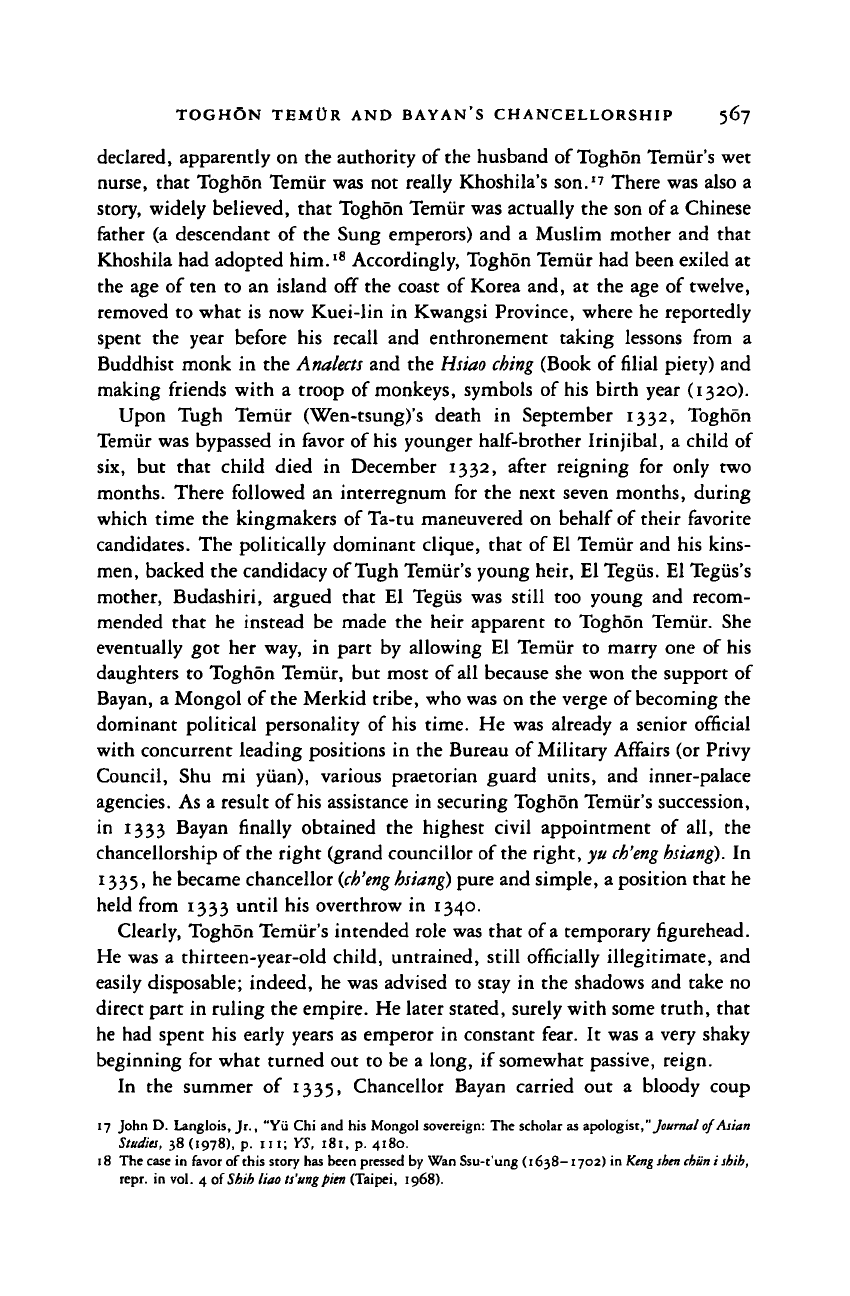
TOGHON TEMOR AND BAYAN'S CHANCELLORSHIP 567
declared, apparently on the authority of the husband of ToghSn Temiir's wet
nurse, that ToghSn Temiir was not really Khoshila's son.'
7
There was also a
story, widely believed, that Toghon Temiir was actually the son of a Chinese
father (a descendant of the Sung emperors) and a Muslim mother and that
Khoshila had adopted him.
l8
Accordingly, Toghon Temiir had been exiled at
the age of ten to an island off the coast of Korea and, at the age of twelve,
removed to what is now Kuei-lin in Kwangsi Province, where he reportedly
spent the year before his recall and enthronement taking lessons from a
Buddhist monk in the Analects and the Hsiao ching (Book of filial piety) and
making friends with a troop of monkeys, symbols of his birth year (1320).
Upon Tugh Temiir (Wen-tsung)'s death in September 1332, ToghSn
Temiir was bypassed in favor of his younger half-brother Irinjibal, a child of
six, but that child died in December 1332, after reigning for only two
months. There followed an interregnum for the next seven months, during
which time the kingmakers of Ta-tu maneuvered on behalf of their favorite
candidates. The politically dominant clique, that of El Temiir and his kins-
men, backed the candidacy of Tugh Temiir's young heir, El Tegiis. El Tegiis's
mother, Budashiri, argued that El Tegiis was still too young and recom-
mended that he instead be made the heir apparent to Toghon Temiir. She
eventually got her way, in part by allowing El Temiir to marry one of his
daughters to Toghon Temiir, but most of all because she won the support of
Bayan, a Mongol of the Merkid tribe, who was on the verge of becoming the
dominant political personality of his time. He was already a senior official
with concurrent leading positions in the Bureau of Military Affairs (or Privy
Council, Shu mi yuan), various praetorian guard units, and inner-palace
agencies. As a result of his assistance in securing Toghon Temiir's succession,
in 1333 Bayan finally obtained the highest civil appointment of all, the
chancellorship of the right (grand councillor of the right, yu
ch'eng
hsiang).
In
1335,
he became chancellor
{ch'eng hsiang)
pure and simple, a position that he
held from 1333 until his overthrow in 1340.
Clearly, Toghon Temiir's intended role was that of
a
temporary figurehead.
He was a thirteen-year-old child, untrained, still officially illegitimate, and
easily disposable; indeed, he was advised to stay in the shadows and take no
direct part in ruling the empire. He later stated, surely with some truth, that
he had spent his early years as emperor in constant fear. It was a very shaky
beginning for what turned out to be a long, if somewhat passive, reign.
In the summer of 1335, Chancellor Bayan carried out a bloody coup
17 John D. Langlois, Jr., "Yii Chi and his Mongol sovereign: The scholar as
apologist,"
Journal of Asian
Studio, 38(1978), p. 111; YS, 181, p. 4180.
18 The case in favor of this story has been pressed by Wan Ssu-t'ung( 1638-1702) in
Keng shen chiin
i shih,
repr. in vol. 4 of Shih liao u'ungpitn (Taipei, 1968).
Cambridge Histories Online © Cambridge University Press, 2008

568 SHUN-TI AND THE END OF Y0AN RULE IN CHINA
against the surviving members of the family of his former colleague El
Temiir, all of whom he charged with treason. He then set in motion an
extraordinary program of reaction, designed, as the Yuan
shih
(Official his-
tory of the Yuan) has it, to "impose the old regulations."'
9
Toghon Temiir's
reign title
(nien bad)
was changed to Chih-yuan, exactly the same as the title
Khubilai had used from 1264 to 1294. With all possible literalism, Bayan
seized the calendar, turned its pages back to the era of the Yuan founding,
and restarted it. What could that have possibly meant? Why did he do it?
Bayan's personal experiences provide a few clues. He and his ancestors had
been
kesigden,
hereditary housemen to the khaghan and his family. As a
youth, Bayan had served as warrior-houseman to Prince Khaishan, and for
bravery in action in the last of the steppe wars (1300-6), he was awarded the
title
ba'atur
(valiant) at a traditional princely convention, or
khuriltai.
When
Khaishan became emperor (posthumous temple name, Wu-tsung; r. 1307-
11),
Bayan assumed a series of high central posts and military commands in
China. After 1311, he served effectively in high-level provincial positions,
during which time he donated large tracts of farmland (given to him by the
emperor) to the
kesig
and to the Tibetan Buddhist hierarch who was chaplain
to the Yuan court. In 1328 he had been a major power behind the succession
of Khaishan's son Tugh Temiir (Wen-tsung). He was, as his biography says,
"resolute, serious, intelligent, and decisive,"
20
at least in his earlier
years.
All
this appears to draw a portrait of an aristocrat of long and wide experience,
with deep personal, ethnic, and institutional loyalties to the more specifically
Mongolian side of that Sino-Mongolian hybrid, the Yuan dynasty.
It is clear that Bayan believed that things had drifted in undesirable
directions in the forty years since Khubilai's death and that he wanted to
restore the status quo ante. But whatever that might mean, it was in no way
clarified by the imperial edict that announced the readoption of the Chih-
yuan reign title. The edict spoke vaguely of portents of celestial warning. It
said that although the realm was enjoying prosperity and peace, the astrolo-
gers had noted irregularities and that these called for improving government
by way of reviving the old norms
(cbiu tien)
that had worked so well under
Khubilai.
21
In other words, major and perhaps painful changes were prom-
ised, at a time when things were officially acknowledged to be fairly quiet in
the realm. Because there was no general sense of
crisis,
because there was no
broad spectrum of political and moral support for what he was trying to do,
and because his program lacked clear definition, Bayan was soon obliged to
use some very forceful means to impose his will.
19 YS, 138, p. 3338.
20 YS, 138, p. 3335.
21 YS, 38, p. 830.
Cambridge Histories Online © Cambridge University Press, 2008
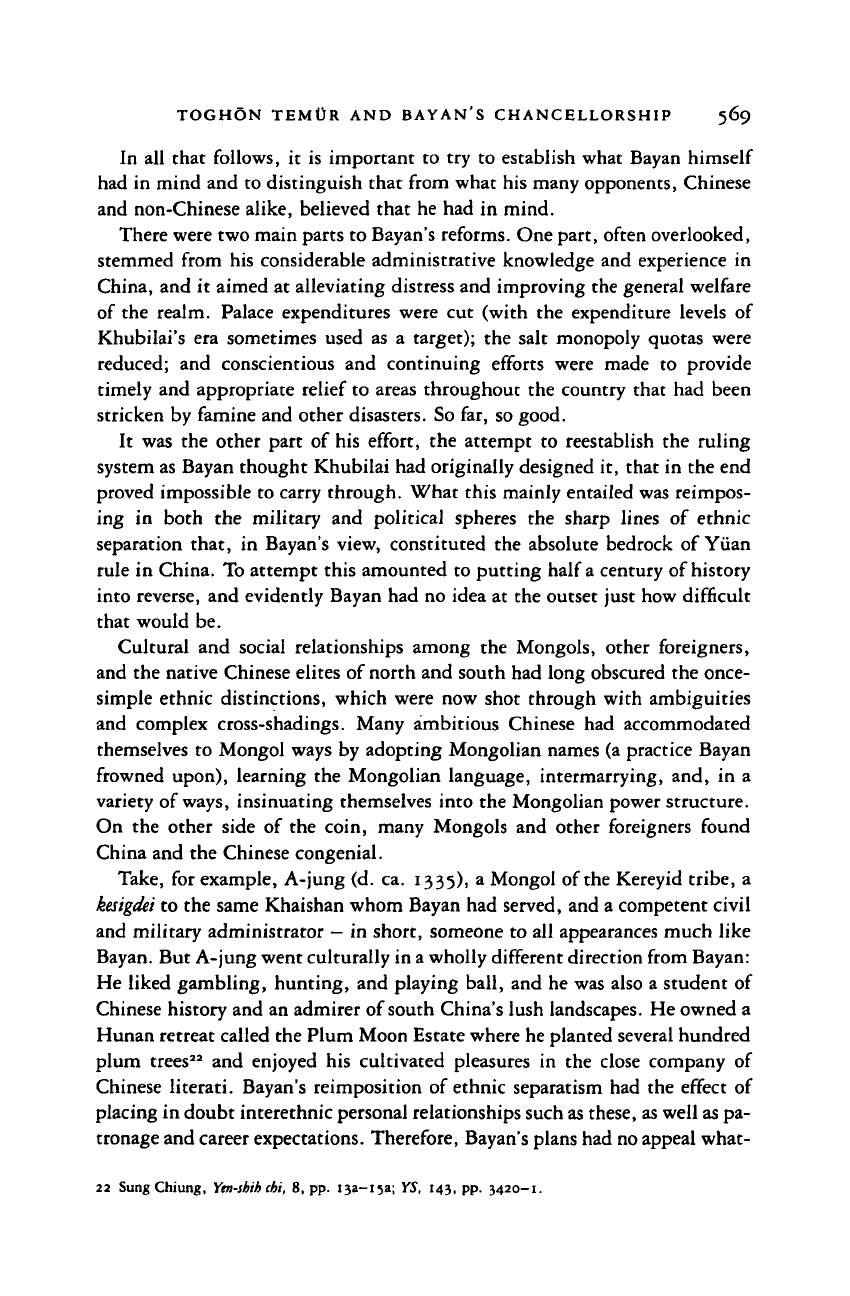
TOGHON TEMOR AND BAYAN'S CHANCELLORSHIP 569
In all that follows, it is important to try to establish what Bayan himself
had in mind and to distinguish that from what his many opponents, Chinese
and non-Chinese alike, believed that he had in mind.
There were two main parts to Bayan's reforms. One part, often overlooked,
stemmed from his considerable administrative knowledge and experience in
China, and it aimed at alleviating distress and improving the general welfare
of the realm. Palace expenditures were cut (with the expenditure levels of
Khubilai's era sometimes used as a target); the salt monopoly quotas were
reduced; and conscientious and continuing efforts were made to provide
timely and appropriate relief to areas throughout the country that had been
stricken by famine and other disasters. So far, so good.
It was the other part of his effort, the attempt to reestablish the ruling
system as Bayan thought Khubilai had originally designed it, that in the end
proved impossible to carry through. What this mainly entailed was reimpos-
ing in both the military and political spheres the sharp lines of ethnic
separation that, in Bayan's view, constituted the absolute bedrock of Yuan
rule in China. To attempt this amounted to putting half a century of history
into reverse, and evidently Bayan had no idea at the outset just how difficult
that would be.
Cultural and social relationships among the Mongols, other foreigners,
and the native Chinese elites of north and south had long obscured the once-
simple ethnic distinctions, which were now shot through with ambiguities
and complex cross-shadings. Many ambitious Chinese had accommodated
themselves to Mongol ways by adopting Mongolian names (a practice Bayan
frowned upon), learning the Mongolian language, intermarrying, and, in a
variety of ways, insinuating themselves into the Mongolian power structure.
On the other side of the coin, many Mongols and other foreigners found
China and the Chinese congenial.
Take, for example, A-jung (d. ca. 1335), a Mongol of the Kereyid tribe, a
kesigdei
to the same Khaishan whom Bayan had served, and a competent civil
and military administrator - in short, someone to all appearances much like
Bayan. But A-jung went culturally in a wholly different direction from Bayan:
He liked gambling, hunting, and playing ball, and he was also a student of
Chinese history and an admirer of south China's lush landscapes. He owned a
Hunan retreat called the Plum Moon Estate where he planted several hundred
plum trees
22
and enjoyed his cultivated pleasures in the close company of
Chinese literati. Bayan's reimposition of ethnic separatism had the effect of
placing in doubt interethnic personal relationships such as these, as well as pa-
tronage and career expectations. Therefore, Bayan's plans had no appeal what-
22 Sung Chiung, Yen-shihehi, 8, pp. 13a—15a; YS, 143, pp. 3420—1.
Cambridge Histories Online © Cambridge University Press, 2008
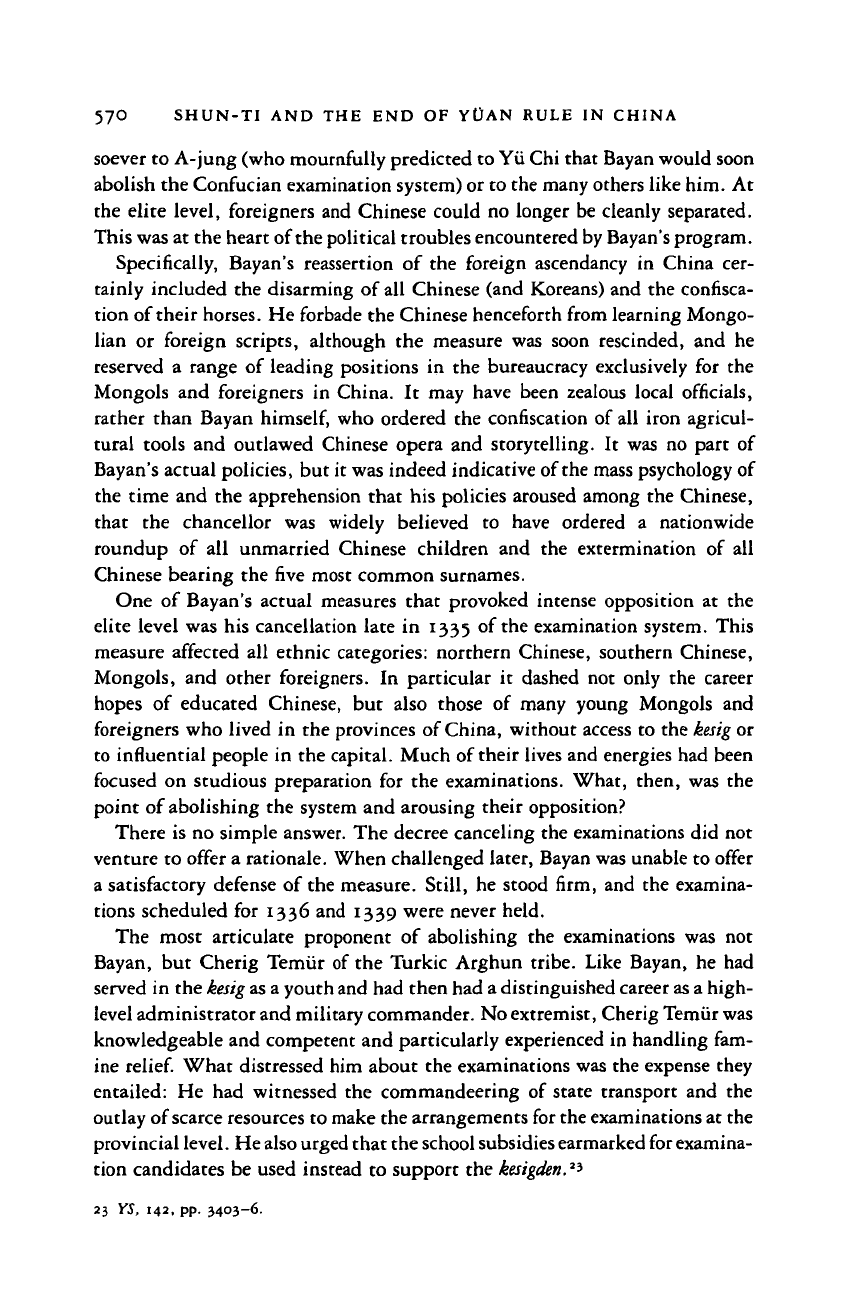
570 SHUN-TI AND THE END OF YtJAN RULE IN CHINA
soever to A-jung (who mournfully predicted to Yii Chi that Bayan would soon
abolish the Confucian examination system) or to the many others like him. At
the elite level, foreigners and Chinese could no longer be cleanly separated.
This was at the heart of the political troubles encountered by Bayan's program.
Specifically, Bayan's reassertion of the foreign ascendancy in China cer-
tainly included the disarming of all Chinese (and Koreans) and the confisca-
tion of their horses. He forbade the Chinese henceforth from learning Mongo-
lian or foreign scripts, although the measure was soon rescinded, and he
reserved a range of leading positions in the bureaucracy exclusively for the
Mongols and foreigners in China. It may have been zealous local officials,
rather than Bayan
himself,
who ordered the confiscation of all iron agricul-
tural tools and outlawed Chinese opera and storytelling. It was no part of
Bayan's actual policies, but it was indeed indicative of the mass psychology of
the time and the apprehension that his policies aroused among the Chinese,
that the chancellor was widely believed to have ordered a nationwide
roundup of all unmarried Chinese children and the extermination of all
Chinese bearing the five most common surnames.
One of Bayan's actual measures that provoked intense opposition at the
elite level was his cancellation late in 1335 of the examination system. This
measure affected all ethnic categories: northern Chinese, southern Chinese,
Mongols, and other foreigners. In particular it dashed not only the career
hopes of educated Chinese, but also those of many young Mongols and
foreigners who lived in the provinces of
China,
without access to the
kesig
or
to influential people in the capital. Much of their lives and energies had been
focused on studious preparation for the examinations. What, then, was the
point of abolishing the system and arousing their opposition?
There is no simple answer. The decree canceling the examinations did not
venture to offer a rationale. When challenged later, Bayan was unable to offer
a satisfactory defense of the measure. Still, he stood firm, and the examina-
tions scheduled for 1336 and 1339 were never held.
The most articulate proponent of abolishing the examinations was not
Bayan, but Cherig Temiir of the Turkic Arghun tribe. Like Bayan, he had
served in the
kesig as
a youth and had then had
a
distinguished career
as
a high-
level administrator and military commander. No extremist, Cherig Temiir
was
knowledgeable and competent and particularly experienced in handling fam-
ine
relief.
What distressed him about the examinations was the expense they
entailed: He had witnessed the commandeering of state transport and the
outlay of scarce resources to make the arrangements for the examinations at the
provincial
level.
He
also
urged that the school subsidies earmarked for examina-
tion candidates be used instead to support the
kesigden.^
23 YS, 142, pp. 3403—6.
Cambridge Histories Online © Cambridge University Press, 2008

TOGHON TEMOR AND BAYAN'S CHANCELLORSHIP 571
Yet the issue went much further than that; it was not solely a matter of
reducing expenses and reallocating resources. Khubilai had never held exami-
nations. Since their institution in 1315, newly minted chin shih had enjoyed
something of an unfair advantage in competing with young clerks and transla-
tors for entry-level positions in the regular bureaucracy, and they had, or
were thought to have, better chances for subsequent promotion. Holding a
degree was beginning to challenge service in the
kesig
for prestige. But a chin
shih degree was no guarantee of administrative competence: Bayan himself
and many others stood witness to that. Rather, abolishing the examinations
was a way to underscore the value of aristocratic hereditary privilege and of
demonstrated practical experience. In preparation for government service,
the study of the Confucian canon, though certainly not proscribed, was
relegated to a secondary position.
So much for the reforms. Following aristocratic custom, after his rise to
the chancellorship Bayan began to accumulate vast personal assets. Chinese
sources hostile to Bayan are careful to list these in detail. He also came to
hold a first-class princely fief and an awesome range of concurrent official
positions over central and palace organs, capital guard units, and patrimonial
business agencies. So crowded were the streets with officials when Bayan's
birthday was celebrated in 1338 that one elderly Chinese official of high rank
was nearly trampled to death.
24
The chancellor's own progresses through the
capital featured a large and impressive military escort that reportedly made
the emperor's entourage look modest by comparison. Perhaps Bayan, his
political aims at least superficially achieved, was beginning to grow compla-
cent and corrupt.
But his position remained insecure. Bayan soon found he had enemies
among a higher stratum of aristocracy than his own. Four enemies whom he
prosecuted were princes of the blood. One of them, Chechegtii (prince of
T'an), posted in command of troops in Mongolia, was arrested in 1338,
brought to Ta-tu, and publicly executed outside one of the east gates. That
was perceived as a grossly unjust act. The prince was held in popular esteem
in the capital, and his standing was also high in Confucian circles in south
China, because he had kept a southern scholar at his court for a time and had
respected his advice.
2
'
And far down the social scale, out in the provinces of China, ominous
commotions came to Bayan's attention. There were several small-scale millen-
arian uprisings in Honan, Kwangtung, and Kiangsi, which were quickly
24 Yang Yii (1285-136:), Shan chii hsin him (TSCC ed.), p. 17a. This work has been translated by
Herbert Franke; see his
Beitrage
zur Kulturgacbichte Chinas
unter der
MongoUnbtmchafi:
Das Sban-ku sin-
hua dts Yang Yii (Wiesbaden, 1956).
25 Wei Su (1303-72), Wei Tai-p'u chi (Wu-hsing, 1913), 8, pp. 8a-9b.
Cambridge Histories Online © Cambridge University Press, 2008
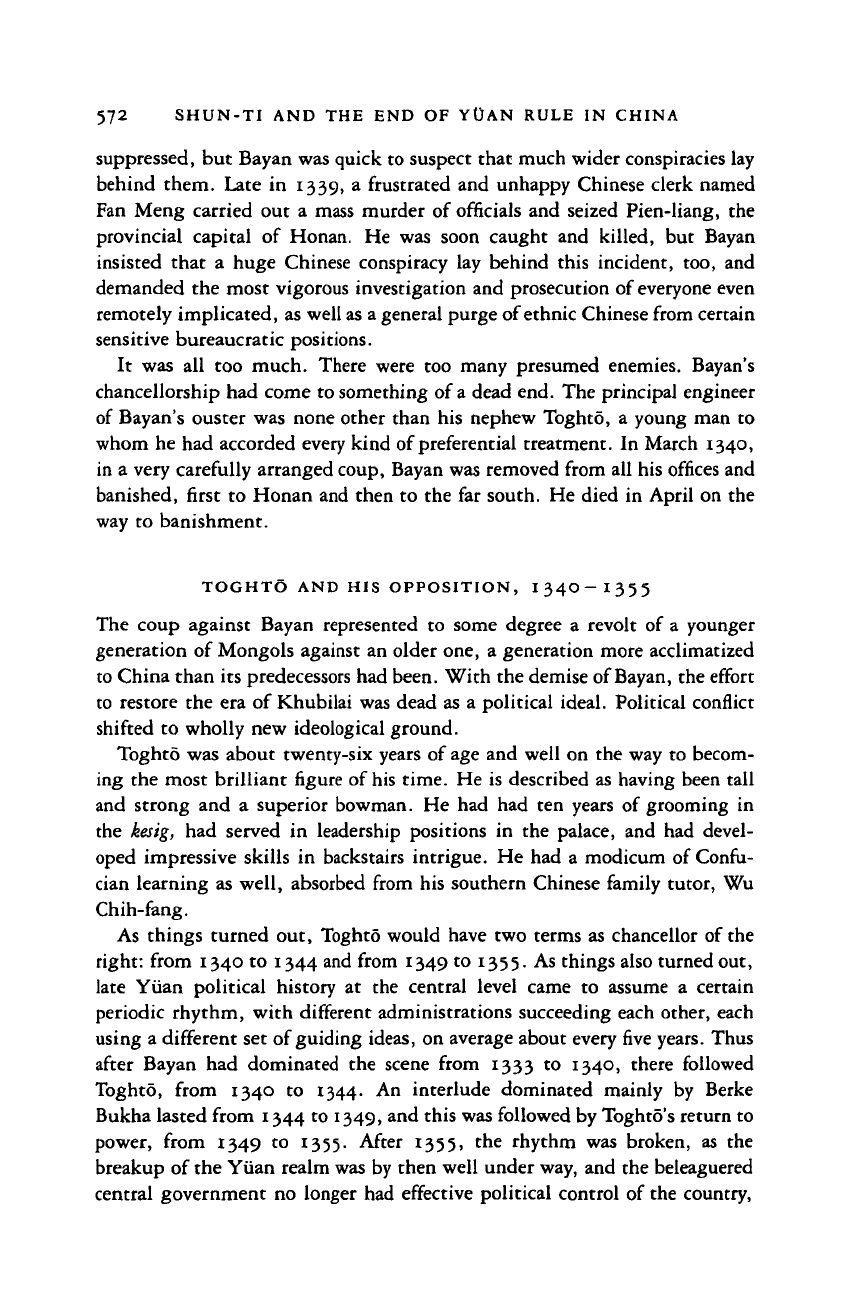
572 SHUN-TI
AND THE END OF
Yt)AN RULE
IN
CHINA
suppressed, but Bayan was quick to suspect that much wider conspiracies lay
behind them. Late
in
1339,
a
frustrated and unhappy Chinese clerk named
Fan Meng carried
out a
mass murder
of
officials and seized Pien-liang,
the
provincial capital
of
Honan.
He was
soon caught
and
killed,
but
Bayan
insisted that
a
huge Chinese conspiracy
lay
behind this incident, too,
and
demanded the most vigorous investigation and prosecution of everyone even
remotely implicated, as well
as
a general purge of ethnic Chinese from certain
sensitive bureaucratic positions.
It
was all too
much. There were
too
many presumed enemies. Bayan's
chancellorship had come to something of
a
dead end. The principal engineer
of Bayan's ouster was none other than
his
nephew Toghto,
a
young man
to
whom he had accorded every kind of preferential treatment.
In
March 1340,
in
a
very carefully arranged coup, Bayan was removed from all his offices and
banished, first
to
Honan and then
to
the
far
south. He died
in
April on
the
way
to
banishment.
TOGHTO AND HIS OPPOSITION, 1340-1355
The coup against Bayan represented
to
some degree
a
revolt
of a
younger
generation
of
Mongols against an older one,
a
generation more acclimatized
to China than its predecessors had been. With the demise of Bayan, the effort
to restore the era
of
Khubilai was dead as
a
political ideal. Political conflict
shifted
to
wholly new ideological ground.
Toghto was about twenty-six years of age and well
on
the way
to
becom-
ing the most brilliant figure of
his
time. He is described as having been tall
and strong
and a
superior bowman.
He had had ten
years
of
grooming
in
the
kesig,
had
served
in
leadership positions
in the
palace,
and had
devel-
oped impressive skills
in
backstairs intrigue.
He
had
a
modicum of Confu-
cian learning as well, absorbed from his southern Chinese family tutor, Wu
Chih-fang.
As things turned out, Toghto would have two terms as chancellor
of
the
right: from 1340
to
1344 and from 1349 to 1355. As things also turned out,
late Yuan political history
at the
central level came
to
assume
a
certain
periodic rhythm, with different administrations succeeding each other, each
using
a
different set of guiding ideas, on average about every
five
years. Thus
after Bayan
had
dominated
the
scene from 1333
to
1340, there followed
Toghto, from
1340 to 1344. An
interlude dominated mainly
by
Berke
Bukha lasted from 1344 to 1349, and this was followed by Toghto's return to
power, from
1349 to
1355. After 1355,
the
rhythm
was
broken,
as the
breakup of the Yuan realm was by then well under way, and the beleaguered
central government
no
longer had effective political control
of
the country,
Cambridge Histories Online © Cambridge University Press, 2008
